Babies
Tips for reading aloud:
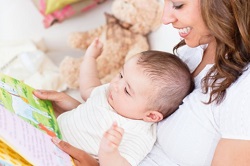 Make reading a part of your daily routine. Reading before bedtime is always great, but feel free to try other times of the day as well.
Make reading a part of your daily routine. Reading before bedtime is always great, but feel free to try other times of the day as well.- Keep books where your baby can reach them! Make sure they are as easy to reach, hold, and look at as other toys. Expect him to put them in his mouth.
- Snuggle up with a book—hold your baby on your lap and find a comfortable place to read. Feeling safe and secure with you while looking at a book builds your baby's confidence and love of reading.
- Allow your baby to look at, hold, or even chew on his books. Help him turn the pages as well.
- Point at pictures and name them as you read. This is how babies learn.
- Vary your tone of voice and make funny faces as you read. Also sing lullabies and recite nursery rhymes.
- Read favorite stories, rhymes, and songs from books over and over again. Repeated fun with books strengthens language development and builds positive feelings about reading.
- Pay attention to your baby's reactions to the books you read. Stop if he isn't enjoying the story, and try another book or another time.
Books to look for:
- Sturdy books that are made of cardboard, cloth, or soft plastic. These are easier for babies to handle.
- Lift-the-flap, touch-and-feel, and peek-through play books. Allow them to peek under the flaps or through the holes to find surprises.
- Books with simple but bright, high-contrast illustrations. These are easier for babies to see and will grab their attention.
- Books with large pictures of things with which babies are familiar. Many babies like books that have pictures of other babies.
Talking and playing with your baby:
- Talk with your baby all day long—describe the weather, what you buy at the store, and what's for supper. Talk about pictures in books or things you see on a walk. Your child learns ideas, words, and how language works by listening to you.Answer your baby's coos, gurgles, smiles, and sounds. Get her to look at you and then talk, touch, and smile back.
- Play simple talking and touching games with your baby. For example, ask where his nose is, then touch it and say "There it is!" Stop when he gets tired of the game. Also try peek-a-boo, pat-a-cake, and other basic games.
Toddlers
Tips for reading aloud:
 Read a little bit several times each day. Bedtime is always great, but feel free to try other times as well.
Read a little bit several times each day. Bedtime is always great, but feel free to try other times as well.- Keep lots of different books within reach around the house and let your toddler choose what to read.
- Let your child move around a little while you are reading! It's okay if he's a little restless or acting out the story while you read to him. He can still listen while he moves.
- Reading to the child helps him learn concentration and how to control himself and sit still. This doesn't come naturally to a toddler, who is usually in constant motion.
- Let your child hold the book himself. Also allow him to turn the pages and fill in words of the story that he knows.
- Have fun while reading! Use different voices, humor, and expression. Take advantage of books that invite movement or making silly sounds.
- Point to pictures and name them as you read—this is how toddlers learn.
- Talk with your child as your read together. Ask what his favorite part is and answer questions about characters or events.
- Read favorite books over and over again.
- Be flexible—don't feel like you have to finish every book you start if your toddler isn't enjoying it. It's all about building positive experiences with books. Try different stories or different times of the day!
- Never use reading as a threat or as a negative consequence. This will immediately turn a child's positive view of reading into a negative one.
Books to look for:
- Stories that are short and simple and have few words. Toddlers have shorter attention spans than babies.
- Engaging books about things your toddler likes. Find books about trucks, animals, children, dinosaurs, trains, machines, or whatever his obsession is at the moment.
- Books with flaps or different textures to keep your toddler's hands busy, or books with detailed illustrations or recurring hidden items in pictures. These are great for exploring and discussing together.
- Alphabet books—teach your child the alphabet song, and play games using the letters.
Talking and playing with your toddler:
- Talk with your child whenever you do something together. Challenge him by asking questions that require more than just a yes or no answer. Encourage him to tell you what he thinks.
- Have your toddler tell you a story and then ask him questions, explaining that you need to understand better. Be an enthusiastic listener!
- Give everything a name—build vocabulary by talking about interesting words and objects, and point out colors, sizes, and shapes.
- Recite rhymes and sing songs. Pause and let your toddler finish a phrase or chant a refrain. Once your toddler is familiar with a rhyme or pattern, make mistakes on purpose and get caught.
- Talk and play games with the alphabet! Buys alphabet blocks, puzzles, or magnets for the fridge. Ask him to name letters he plays with and say words he's trying to spell.
- Point out print to you toddler whenever you go out. Call attention to letters and words in billboards, posters, labels, and street signs.
Preschool
Tips for reading aloud:
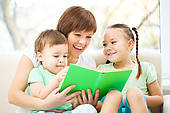 Read together for at least 15-20 minutes every day. Before bed is always great, but feel free to try other times as well!
Read together for at least 15-20 minutes every day. Before bed is always great, but feel free to try other times as well!- Eliminate distractions while reading—turn off the computer, TV, and radio.
- Try to go to the library on a weekly basis to let your child choose new books.
- Have your child arrange his books in some order around the house, maybe by his favorites or by topic.
- Have your child sit close to you or on your lap as you read. Make it a warm and loving time when you can cuddle close.
- Let your child turn the pages.
- Have fun while reading! Use different voices, humor, and expression. Take advantage of books that invite movement or making silly sounds.
- Be interactive—talk about what's happening in the book, ask questions, and point out objects, animals, or people on each page.
- Talk about how books are written—point out that we read left to right and that words are separated by spaces.
- Read rhymes to your child. As you read, stop before a rhyming word and ask your child to fill in the blank, making sure to praise him afterward.
- Read favorite books again and again.
- Know when to stop—put the book away if your child loses interest or is having trouble paying attention.
- Tell your child how much you enjoy reading with him! Talk about "story time" as the favorite part of your day.
- Give books as gifts and rewards and encourage family members to do the same!
- Never use reading as a threat or as a negative consequence. This will immediately turn a child's positive view of reading into a negative one.
- See a pediatrician or teacher as soon as possible if you have concerns about your child's language development, hearing, or sight.
Books to look for:
- Longer books that tell stories about families, friends, going to school, or other things that relate to your child's life. Continue to look for books about your child's favorite things, whether they are dinosaurs, horses, trains, or sports.
- Try some books without words, and make up the story yourselves based on the pictures.
- Alphabet, counting, and rhyming books.
Talking, playing, and writing with your Preschooler:
- Give everything a name—build vocabulary by talking about interesting words and objects, and point out colors, sizes, and shapes.
- Have your child tell you stories, and then ask follow-up questions, explaining that you need to understand more. Be an enthusiastic listener!
- Recite nursery rhymes, say tongue twisters, play word games, and sing silly songs together.
- Play with alphabet blocks, puzzles, or fridge magnets. Ask your child to name letters he plays with and say words he's trying to spell.
- Point out words everywhere—on signs, billboards, labels, and posters. Ask your child to name letters and find new words whenever you go out.
- On road trips, play an alphabet game—find words on billboards or signs that start with the letter A, then B, then all the way through the alphabet in order.
- Encourage your child to write and spell his name.
Kindergarten
Tips for reading:
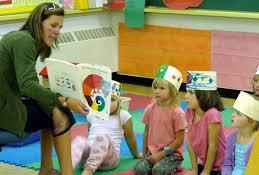 Read every day for at least 15-20 minutes. Before bed is always great, but feel free to try other times as well.
Read every day for at least 15-20 minutes. Before bed is always great, but feel free to try other times as well.- Eliminate distractions while reading. Turn off the computer, TV, and radio.
- Try to go to the library on a weekly basis to let your child choose new books.
- Pick books that are the right level—make sure they are not too difficult. You want to give your child successful reading experiences.
- Connect books to what happens in real life. Relate stories to trips you've taken or things that happen at school.
- Have fun while reading! Use different voices, humor, and expression. Take advantage of books that invite movement or making silly sounds.
- Ask your child questions about the story, such as "Why do you think he did that?" or "Who's your favorite character?" Make sure he knows what's happening in the story, and try to make predictions with him about what will happen next.
- Be patient. Give your child time to sound out unfamiliar words, and remind him to look closely at the letters.
- When your child makes a mistake, gently point out the letters he overlooked or read incorrectly. Many beginners will wildly guess at new words based on the first letter.
- After you read a book together, ask your child to retell you the story.
- Read favorite books again and again.
- Make books special! Give them as gifts and rewards and encourage family members to do the same.
- Bring books along any time your child has to wait. Don't leave home without one!
- Never use reading as a threat or as a negative consequence. This will immediately turn a child's positive view of reading into a negative one.
Helping your child with letters and sounds:
- Point out links between letters and sounds. For example, point out words that start with the same letter as your child's name: "Ryan, the word run starts with the same sound as your name. Ryan, run. And they both start with the letter R."
- Trace and say letters. Have your child use his finger to trace a letter while saying its sound. Do this on paper, sand, or sugar.
- Practice blending sounds into words. Ask "Can you guess what this word is? P – A – N. Hold each letter sound longer than normal.
Talking with your child:
- Talk about everyday activities to build background knowledge. Keep up a constant chatter while cooking, visiting new places, or doing chores.
- Have your child tell you stories, and ask follow-up questions. Be an enthusiastic listener!
- Recite nursery rhymes, say tongue twisters, play word games, and sing silly songs together!
- Point out words everywhere—on signs, billboards, labels, and posters. Ask your child to name letters and find new words whenever you go out.
First Grade
Tips for reading:
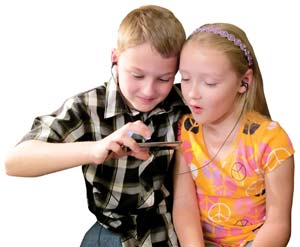 Read every day for at least 20 minutes. Before bed is always great, but feel free to try other times as well.
Read every day for at least 20 minutes. Before bed is always great, but feel free to try other times as well.- Eliminate distractions while reading. Turn off the computer, TV, and radio.
- Try to visit the library on a weekly basis to let your child choose new books.
- Pick books that are the right level—make sure they are not too difficult. You want to give your child successful reading experiences.
- Take turns reading aloud.
- Connect books to what happens in real life. Relate stories to trips you've taken or things that happen at school.
- Have fun while reading! Use different voices, humor, and expression. Take advantage of books that invite movement or making silly sounds.
- Ask your child questions about the story, such as "Why do you think he did that?" or "Who's your favorite character?" Make sure he knows what's happening in the story, and try to make predictions with him about what will happen next.
- Be patient. Give your child time to sound out unfamiliar words, and remind him to look closely at the letters.
- When your child makes a mistake, gently point out the letters he overlooked or read incorrectly. Many beginners will wildly guess at new words based on the first letter.
- After sounding out a new word, have your child reread the sentence it was in to improve understanding.
- After you read a book together, ask your child to retell you the story.
- Read favorite books again and again.
- Make books special! Give them as gifts and rewards and encourage family members to do the same.
- Bring books along any time your child has to wait. Don't leave home without one!
- Try buying audio books to listen to together on long drives. You can also listen to them at home to supplement your regular reading routine, but make sure they don't replace reading together with an actual book.
- Consider subscribing to National Geographic for Kids or a similar children's publication. These magazines have lots of interesting stories and pictures for children that can get them excited about reading. Receiving mail each month can also be a fun experience for them to look forward to.
- Never use reading as a threat or as a negative consequence. This will immediately turn a child's positive view of reading into a negative one.
Teaching and talking with your child:
- Talk every day about things going on at school or around the house to build background knowledge. Keep up a constant chatter while cooking, visiting new places, or doing chores. Add interesting words into the conversation and build on words talked about in the past.
- Have your child tell you stories, and ask follow-up questions. Be an enthusiastic listener! Also tell some stories yourself about when you were younger.
- Recite nursery rhymes, say tongue twisters, and sing silly songs together!
- Point out words everywhere—on signs, billboards, labels, and posters. Ask your child to find new words whenever you go out.
- On car trips, play an alphabet game—find words on billboards or signs that start with the letter A, then B, and then all the way through the alphabet in order.
- Play word games—have your child sound out words as you change letters—sit to pit to hit, hit to hut to hot, and hot to hog.
- Point to objects around the house and then ask your child to think of as many rhyming words as he can. Toy, ball, bed, rug, and sink all work well.
- Have your child help you write out a grocery list, thank-you note, or keep a journal of special things that happen at home. Encourage him to use letter and sound patterns that he's learning at school.
- Make a message board and leave notes there for your child, making sure he finds them. Encourage him to write messages back.
Second Grade
Tips for reading:
 Read every day for at least 20 minutes. Before bed is always great, but feel free to try other times as well.
Read every day for at least 20 minutes. Before bed is always great, but feel free to try other times as well.- Eliminate distractions while reading. Turn off the computer, TV, and radio.
- Try to visit the library on a weekly basis to let your child choose new books.
- Pick books that are the right level—make sure they are not too difficult. You want to give your child successful reading experiences.
- Take turns reading aloud.
- Connect books to what happens in real life. Relate stories to trips you've taken or things that happen at school.
- Have fun while reading! Use different voices, humor, and expression. Take advantage of books that invite movement or making silly sounds.
- Ask child questions about the story, such as "Why do you think he did that?" or "Who's your favorite character?" Make sure he knows what's happening in the story, and try to make predictions with him about what will happen next.
- Be patient. Give your child time to sound out unfamiliar words, and remind him to look closely at the letters.
- When your child makes a mistake, gently point out the letters he overlooked or read incorrectly. Many beginners will wildly guess at new words based on the first letter.
- After sounding out a new word, have your child reread the sentence it was in to improve understanding.
- After you read a book together, ask your child to retell you the story.
- Read favorite books again and again. As you read, pause and ask what is going on in the story.
- Make books special! Give them as gifts and rewards and encourage family members to do the same.
- Bring books along any time your child has to wait. Don't leave home without one! Try buying audio books to listen to together on long drives. You can also listen to them at home to supplement your regular reading routine, but make sure they don't replace reading together with an actual book.
- Consider subscribing to National Geographic for Kids or a similar children's publication. These magazines have lots of interesting stories and pictures for children that can get them excited about reading. Receiving mail each month can also be a fun experience for them to look forward to.
- Never use reading as a threat or as a negative consequence. This will immediately turn a child's positive view of reading into a negative one.
Teaching and talking with your child:
 Talk every day about things going on at school or around the house to build background knowledge. Keep up a constant chatter while cooking, visiting new places, or doing chores. Add interesting words into the conversation and build on words talked about in the past.
Talk every day about things going on at school or around the house to build background knowledge. Keep up a constant chatter while cooking, visiting new places, or doing chores. Add interesting words into the conversation and build on words talked about in the past.- Have your child tell you stories, and ask follow-up questions. Be an enthusiastic listener! Also tell some stories yourself about when you were younger.
- Recite nursery rhymes, say tongue twisters, and sing silly songs together!
- Read poems/storybooks and ask your child to act them out using different faces and movements that go along with the words. Tell him that his family would love to see him perform and act out the stories for them!
- Point out words everywhere—on signs, billboards, labels, and posters. Ask your child to find new words whenever you go out.
- On car trips, play an alphabet game—find words on billboards or signs that start with the letter A, then B, then all the way through the alphabet in order.
- Take turns making up a story while riding in a car or bus, with each of you adding one sentence at a time. Try to make it funny or spooky.
- Play word games—have your child sound out words as you change letters—sit to pit to hit, hit to hut to hot, and hot to hog.
- Point to objects around the house and then ask your child to think of as many rhyming words as she can. Toy, ball, bed, rug, and sink all work well.
- Have your child help you write out a grocery list, thank-you note, or keep a journal of special things that happen at home. Encourage him to use letter and sound patterns that he's learning at school.
- Make a message board and leave notes there for your child, making sure he finds them. Encourage him to write messages back.
Third Grade
Tips for reading:
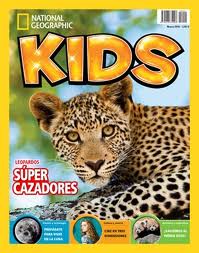 Read every day for at least 20 minutes. Before bed is always great, but feel free to try other times as well.
Read every day for at least 20 minutes. Before bed is always great, but feel free to try other times as well.- Eliminate distractions while reading. Turn off the computer, TV, and radio.
- Try to visit the library on a weekly basis to let your child choose new books.
- Pick books that are the right level—make sure they are not too difficult. You want to give your child successful reading experiences.
- Take turns reading aloud.
- Connect books to what happens in real life. Relate stories to trips you've taken or things that happen at school.
- Have fun while reading! Use different voices, humor, and expression. Take advantage of books that invite movement or making silly sounds.
- Ask child questions about the story, such as "Why do you think he did that?" or "Who's your favorite character?" Make sure he knows what's happening in the story, and try to make predictions with him about what will happen next.
- Be patient. Give your child time to sound out unfamiliar words, and remind him to look closely at the letters.
- When your child makes a mistake, gently point out the letters he overlooked or read incorrectly. Many beginners will wildly guess at new words based on the first letter.
- After sounding out a new word, have your child reread the sentence it was in to improve understanding.
- After you read a book together, ask your child to retell you the story.
- Read favorite books again and again.
- Introduce series like Harry Potter or The Boxcar Children, or suggest a second book by a favorite author. Also ask a librarian for suggestions.
- Consider subscribing to National Geographic for Kids or a similar children's publication. These magazines have lots of interesting stories and pictures for children that can get them excited about reading. Receiving mail each month can also be a fun experience for them to look forward to.
- Buy some kid's versions of biographies of famous people and see if your child is interested. He may enjoy reading about well-known people he has heard of and will learn a lot in the process.
- Have your daughter try the American Girl series. These books incorporate history from the 1600s up until to the recent times and are entertaining at the same time.
- Let your child see you use a dictionary. For example, say "Hmm, I don't know what that word means. I think I'll look it up."
- Make books special! Give them as gifts and rewards and encourage family members to do the same.
- Bring books along any time your child has to wait. Don't leave home without one!
- Try buying audio books to listen to together on long drives. You can also listen to them at home to supplement your regular reading routine, but make sure they don't replace reading together with an actual book.
- Never use reading as a threat or as a negative consequence. This will immediately turn a child's positive view of reading into a negative one.
Teaching and talking with your child:
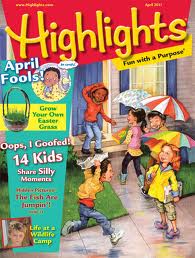 Talk every day about things going on at school or around the house to build background knowledge. Keep up a constant chatter while cooking, visiting new places, or doing chores. Add interesting words into the conversation and build on words talked about in the past.
Talk every day about things going on at school or around the house to build background knowledge. Keep up a constant chatter while cooking, visiting new places, or doing chores. Add interesting words into the conversation and build on words talked about in the past.- Have your child tell you stories, and ask follow-up questions. Be an enthusiastic listener! Also tell some stories yourself about when you were younger.
- Recite nursery rhymes, say tongue twisters, and sing silly songs together!
- Read poems/storybooks and ask your child to act them out using different faces and movements that go along with the words. Tell him that his family would love to see him perform and act out the stories for them!
- Point out words everywhere—on signs, billboards, labels, and posters. Ask your child to find new words whenever you go out.
- On car trips, play an alphabet game—find words on billboards or signs that start with the letter A, then B, then all the way through the alphabet in order.
- Take turns making up a story while riding in a car or bus, with each of you adding one sentence at a time. Try to make it funny or spooky.
- Play word games—have your child sound out words as you change letters—sit to pit to hit, hit to hut to hot, and hot to hog.
- Point to objects around the house and then ask your child to think of as many rhyming words as she can. Toy, ball, bed, rug, and sink all work well.
- Have your child help you write out a grocery list, thank-you note, or keep a journal of special things that happen at home. Encourage him to use letter and sound patterns that he's learning at school.
- Make a message board and leave notes there for your child, making sure he finds them. Encourage him to write messages back.
Sources:
Reading Rockets
Reading Foundation
Colorin Colorado
 Make reading a part of your daily routine. Reading before bedtime is always great, but feel free to try other times of the day as well.
Make reading a part of your daily routine. Reading before bedtime is always great, but feel free to try other times of the day as well. Read a little bit several times each day. Bedtime is always great, but feel free to try other times as well.
Read a little bit several times each day. Bedtime is always great, but feel free to try other times as well. Read together for at least 15-20 minutes every day. Before bed is always great, but feel free to try other times as well!
Read together for at least 15-20 minutes every day. Before bed is always great, but feel free to try other times as well! Read every day for at least 15-20 minutes. Before bed is always great, but feel free to try other times as well.
Read every day for at least 15-20 minutes. Before bed is always great, but feel free to try other times as well. Read every day for at least 20 minutes. Before bed is always great, but feel free to try other times as well.
Read every day for at least 20 minutes. Before bed is always great, but feel free to try other times as well. Read every day for at least 20 minutes. Before bed is always great, but feel free to try other times as well.
Read every day for at least 20 minutes. Before bed is always great, but feel free to try other times as well. Talk every day about things going on at school or around the house to build background knowledge. Keep up a constant chatter while cooking, visiting new places, or doing chores. Add interesting words into the conversation and build on words talked about in the past.
Talk every day about things going on at school or around the house to build background knowledge. Keep up a constant chatter while cooking, visiting new places, or doing chores. Add interesting words into the conversation and build on words talked about in the past. Read every day for at least 20 minutes. Before bed is always great, but feel free to try other times as well.
Read every day for at least 20 minutes. Before bed is always great, but feel free to try other times as well. Talk every day about things going on at school or around the house to build background knowledge. Keep up a constant chatter while cooking, visiting new places, or doing chores. Add interesting words into the conversation and build on words talked about in the past.
Talk every day about things going on at school or around the house to build background knowledge. Keep up a constant chatter while cooking, visiting new places, or doing chores. Add interesting words into the conversation and build on words talked about in the past.